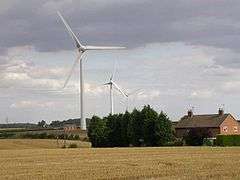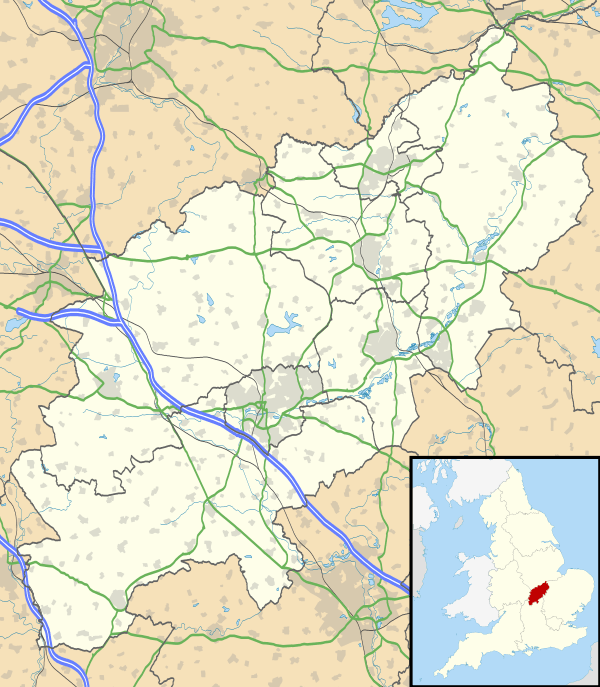Burton Latimer
| Burton Latimer | |
|---|---|
 Burton Wold Wind Farm | |
 Burton Latimer Burton Latimer shown within Northamptonshire | |
| Population | 7,449 (2011 census) |
| OS grid reference | SP901749 |
| District | |
| Shire county | |
| Region | |
| Country | England |
| Sovereign state | United Kingdom |
| Post town | KETTERING |
| Postcode district | NN15 |
| Dialling code | 01536 |
| Police | Northamptonshire |
| Fire | Northamptonshire |
| Ambulance | East Midlands |
| EU Parliament | East Midlands |
| UK Parliament | |
Burton Latimer is a town in Northamptonshire, England, with a population in 2011 of 7,449.
History
Burton (Latimer) appears in 3 entries in the Domesday Book of 1086. [1]
Tenant-in-chief and Lord in 1086: Guy of Raimbeaucourt. Households: 21 villagers. 18 smallholders. 1 slave. Ploughland: 14 ploughlands (tre). 3 lord's plough teams. 9 men's plough teams. Other resources: 3.0 lord's lands. Meadow 20 acres. Woodland 0.5 acres. 2 mills, value 0.8. Phillimore reference: 41,1
Tenant-in-chief in 1086: Bishop Geoffrey of Coutances. Lord in 1086: Walkelin of Harrowden. Households: 9 villagers. 5 smallholders. 1 slave. 1 female slave. Ploughland: 5 ploughlands (land for). 2 lord's plough teams. 3.5 men's plough teams. Other resources: Meadow 15 acres. Phillimore reference: 4,9
Tenant-in-chief in 1086: Bishop Geoffrey of Coutances. Lord in 1086 Richard Households: 3 villagers. 1 smallholder. 1 slave. Ploughland: 3 ploughlands (land for). 1 lord's plough teams. 1 men's plough teams. Other resources: Meadow 6 acres. Phillimore reference: 4,12
In the reign of Edward the Confessor (1042-1066), Earl Ralph, probably the Earl of Hereford, held 8½ hides of land, which constituted, until the first half of the 13th century the whole of the Manor of Burton, and paid the service due from 1.5 Knight's Fees.
In 1086 the manor was held directly from the king by Guy de Reinbuedcurt (Reimbeaucourt), whose youngest son, Richard, was the tenant under Henry I (1100-1135). Richard is said to have pledged the manor in payment of a gambling debt to the king, who then granted it to hold at pleasure, to Alan de Dinant, a Breton who defeated the champion of the King of France near Gisors.[2]
The town's name is derived from the le Latimer family who lived there in the 13th century.[3] Before the arrival of the Latimers, it was known as 'Burtone'. It grew in the 19th Century around the ironstone quarrying, clothing and footwear industries. A watermill used for grinding corn was converted and used at various times in the 19th century for the manufacture of silk, worsted and carpet-weaving, followed by its conversion to a steam mill to make chicory, mustard, animal foodstuffs and flour. The mill was acquired in the 1930s and became the home of Weetabix. In the last part of the 19th century, two new industries arrived.
By 1885, the first four clothing factories had opened, followed in 1898 by the first shoe factory, and Burton grew rapidly to become a small, thriving light-industrial town.
Quarrying began in about 1872 to the north of the town, to the south of the Kettering to Thrapston railway. More quarries were started in the west in the vicinity of Polwell Lane and more extensively on the north east,east and south east of the town.The last pits ceased production of iron ore in 1921. The ore was taken by tramways to the Kettering Thrapston railway and to the main line north of Isham and Burton Latimer Station. At first the tramways were worked by horses but steam locomotives were introduced from about 1892. Up to 1921 there is no mention of any quarrying machines being used so the ore would have been dug by hand with the aid of explosives. The quarry near Polwell Lane was re-opened in 1925 for the obtaining of gannister (silica sand) The tramway to the main railway from this quarry was operated by small diesel locomotives. Occasionally a little ironstone was quarried. By 1983 however, the quarry ceased production. This area appears to be now occupied by Morrison's distribution centre. There are a few traces of the quarries and tramways but most of the land has been landscaped or built on.[4]
By 2000 the town's new bypass and the building of the A14 made the town attractive again as a manufacturing and distribution centre. High-profile national firms like Versalift, Alpro Soya and Abbeyboard have based themselves on the north side of town.
A notable building in the town is the parish church, dedicated to St Mary the Virgin, which was consecrated in 1147. It contains a number of medieval wall paintings, a 15th-century chancel screen and some memorial brasses. The oldest of the latter is located between the south arcade and chancel screen and features the coat of arms of the Boyville family; it was almost certainly placed there in the early 16th century to commemorate Richard Boyville, his wife Gresyll and their children.[5]
Landmarks
The war memorial was erected in 1922.
The town is home to the land-owning Harpur family, who have owned the Grade I listed Burton Latimer Hall since 1760, together with other land around the town.
There is a Jacobean House, built in 1622, which was formerly a school.
The parish church, dedicated to St Mary the Virgin, was consecrated in 1147. The Norman church was remodelled and added to at various times up to about 1310. It was restored and the tower rebuilt in 1866.[6]
Modern day
Burton Latimer is the location of the first wind farm in Northamptonshire. Burton Wold Wind Farm, operated by Your Energy,[7] has 10 turbines, producing enough electricity to power around 8,500 homes annually.[8] The wind farm is the largest inland wind farm. Burton Latimer is home to the Weetabix food company, Shield aluminium, and several group undertakings[9] and a Wm Morrisons supermarket distribution centre, which are major local employers. Weetabix is also made in Corby.
There are two chip shops, three Indian restaurants, two Italian restaurants, and numerous shops. There is a Sainsbury's store, and a One Stop store.
The town has the Beavers, Cubs, and Scouts based at a hut.
In addition to the ancient St. Mary's Church (built in 1187), there are 4 churches in the town. The other 3 are: Burton Latimer Methodist Church, Burton Latimer Baptist Church, and St. Nicholas Owen RC Church.
There is the Britannia Working Men's Club, the Olde Victoria and a band club. There is a Conservative club, and a civic centre, as well as a community centre.
There is a Pocket Park, established in 1995, with 11 acres of land and wildlife. There is the millennium gardens, constructed in 2000.
There is a medical centre (Burton Latimer Medical Centre), which has a surgery in the town, as well as one in Finedon. The medical centre was completed in 2004, to replace the previous centre, which had been built in 1970. It has doctors, general practitioners, and nurse practitioners. The pharmacy (in Burton Latimer) is next to the centre. Most referrals are made to Kettering General Hospital.
There have been many new houses built, such as the estates of Latimer Gardens, Buckby Grange and Mutlow Estate.
Governance
Burton Latimer has a town council consisting of 12 members, a mayor and deputy mayor. The town's secondary level of local governance is Kettering Borough Council, and the highest level is Northamptonshire County Council. At Westminster, Burton Latimer is part of the Kettering constituency.
Transport
It is just south of the junction of the A6 and A14. The A6 bypass, which is 2 miles long, was completed in October 1991. Buses run through Burton Latimer. These include the X1, 49, and 50.
Isham and Burton Latimer railway station served the town between 1857 and 1950. Now the nearest railway station is at Kettering.
Sport
Burton Latimer has a non-league football team Burton Park Wanderers F.C. who play at Latimer Park. In 2013, Kettering Town moved in with Burton Park Wanderers following financial mismanagement and poor attendances, and still are playing there.
Burton Latimer has an amateur cricket team, Burton Latimer Town Cricket Club, who play at Hall Field, on Kettering Road. It has three XI sides, and one female XI The first XI play in Division 1 of the Northamptonshire Cricket League, the second XI play in Division 6 of the Northamptonshire Cricket League, and the third XI play in Division 11 of the Northamptonshire Cricket League.
The town also has a bowls club, as well as various sports club, based at various community centres. There are tennis courts, by the recreation ground.
Education
The town has two main primary schools: Meadowside Primary School, and St. Mary's C of E Primary School. The town has no secondary schools, but a common, yet incorrect, assumption is that the nearby Latimer Arts College is in the town - it was intended to be, but is instead located in nearby Barton Seagrave, close to Kettering.
There are two nurseries, Acorn Day Nursery, and Appletree Day Nursery.
Twin Towns
Burton Latimer has a town twinning agreement with:
Notable residents
- Richard Boyville, landowner and courtier
- Henry Gage, 16th-century landowner
References
- ↑ http://opendomesday.org/place/SP9074/burton-latimer/
- ↑ http://www.burtonlatimer.info/history/Burton-Manors.html
- ↑ Mills, A.D. (1998). Oxford Dictionary of English Place-names, Oxford: Oxford University Press. ISBN 0-19-280074-4
- ↑ Tonks, Eric (1991). The Ironstone Quarries of the Midlands Part V the Kettering Area. Cheltenham: Runpast. pp. 10–29. ISBN 1-870754-05-0.
- ↑ http://www.burtonlatimer.info/churches/St%20Mary'shistory.html
- ↑ Pevsner, Nikolaus (1973) [1961]. Cherry, Bridget, ed. Northamptonshire (Second ed.). London: Penguin. pp. 131–2. ISBN 0-14-0710-22-1.
- ↑ Your Energy
- ↑ Burton Wold Wind Farm Archived 9 July 2009 at the Wayback Machine.
- ↑ Alumasc Precision Limited website
- ↑ Burton Latimer Online: Twin Towns Retrieved 16 August 2015
- ↑ Burton Latimer Online: Twin Towns Retrieved 16 August 2015